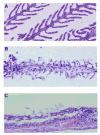Structure and absolute configuration of karlotoxin-2, an ichthyotoxin from the marine dinoflagellate Karlodinium veneficum
- PMID: 20155901
- PMCID: PMC2836391
- DOI: 10.1021/ja9091853
Structure and absolute configuration of karlotoxin-2, an ichthyotoxin from the marine dinoflagellate Karlodinium veneficum
Abstract
In an attempt to determine the cause of repeated fish kills in an estuarine aquaculture facility in Maryland, a toxin with hemolytic, cytotoxic, and ichthyotoxic properties, designated as karlotoxin-2 (KmTx2), was isolated from Karlodinium veneficum. The structure of KmTx2 was elucidated by means of detailed ID and 2D NMR spectra, including 2D INADEQUATE. The relative and absolute configurations of KmTx2 were determined using J-based configuration analysis and comparison of its degradation products with synthetic controls.
Figures




Similar articles
-
Structure and relative potency of several karlotoxins from Karlodinium veneficum.J Nat Prod. 2010 Aug 27;73(8):1360-5. doi: 10.1021/np100158r. J Nat Prod. 2010. PMID: 20795740 Free PMC article.
-
Two new karlotoxins found in Karlodinium veneficum (strain GM2) from the East China Sea.Harmful Algae. 2016 Sep;58:66-73. doi: 10.1016/j.hal.2016.08.001. Epub 2016 Aug 27. Harmful Algae. 2016. PMID: 28073460 Free PMC article.
-
Limaol: A Polyketide from the Benthic Marine Dinoflagellate Prorocentrum lima.J Nat Prod. 2017 May 26;80(5):1688-1692. doi: 10.1021/acs.jnatprod.7b00127. Epub 2017 Apr 6. J Nat Prod. 2017. PMID: 28383915
-
The expanding role of marine microbes in pharmaceutical development.Curr Opin Biotechnol. 2010 Dec;21(6):780-6. doi: 10.1016/j.copbio.2010.09.013. Epub 2010 Oct 16. Curr Opin Biotechnol. 2010. PMID: 20956080 Free PMC article. Review.
-
Marine toxins and the cytoskeleton: pectenotoxins, unusual macrolides that disrupt actin.FEBS J. 2008 Dec;275(24):6082-8. doi: 10.1111/j.1742-4658.2008.06714.x. Epub 2008 Oct 24. FEBS J. 2008. PMID: 19016860 Review.
Cited by
-
Ichthyotoxic Karlodinium veneficum (Ballantine) J Larsen in the Upper Swan River Estuary (Western Australia): Ecological conditions leading to a fish kill.Harmful Algae. 2015 Sep;48:83-93. doi: 10.1016/j.hal.2015.07.006. Epub 2015 Aug 12. Harmful Algae. 2015. PMID: 27642270 Free PMC article.
-
Acute toxicity of karlotoxins to mice.Toxicon. 2014 Nov;90:184-90. doi: 10.1016/j.toxicon.2014.08.003. Epub 2014 Aug 20. Toxicon. 2014. PMID: 25150200 Free PMC article.
-
The Missing Piece in Biosynthesis of Amphidinols: First Evidence of Glycolate as a Starter Unit in New Polyketides from Amphidinium carterae.Mar Drugs. 2017 May 31;15(6):157. doi: 10.3390/md15060157. Mar Drugs. 2017. PMID: 28561749 Free PMC article.
-
Amphidinol 3 preferentially binds to cholesterol in disordered domains and disrupts membrane phase separation.Biochem Biophys Rep. 2021 Feb 10;26:100941. doi: 10.1016/j.bbrep.2021.100941. eCollection 2021 Jul. Biochem Biophys Rep. 2021. PMID: 33614998 Free PMC article.
-
Structure and relative potency of several karlotoxins from Karlodinium veneficum.J Nat Prod. 2010 Aug 27;73(8):1360-5. doi: 10.1021/np100158r. J Nat Prod. 2010. PMID: 20795740 Free PMC article.
References
-
- Harvell CD, Kim K, Burkholder JM, Colwell RR, Epstein PR, Grimes DJ, Hofmann EE, Lipp EK, Osterhaus ADME, Overstreet RM, Porter JW, Smith GW, Vasta GR. Science. 1999;285:1505–1510. - PubMed
-
- Grattan LM, Oldach D, Perl TM, Lowitt MH, Matuszak DL, Dickson C, Parrott C, Shoemaker RC, Kauffman CL, Wasserman MP, Hebel JR, Charache P, Morris JG., Jr Lancet. 1998;352:532–539. - PubMed
-
- Burkholder JM, Glasgow HB. Archiv Protistenk. 1995;145:177–188.
-
- Place AR, Saito K, Deeds JR, Robledo JAF, Vasta GR. A decade of research on Pfiesteria spp, and their toxins: unresolved questions and an alternative hypothesis. In: Botana LM, editor. SEAFOOD AND FRESHWATER TOXINS. 2nd. CRC Press; Florida, U.S.: 2008. pp. 717–751.
-
- Moeller PDR, Beauchesne KR, Huncik KM, Davis WC, Christopher SJ, Riggs-Gelasco P, Gelasco AK. Environ Sci Technol. 2007;41:1166–1172. - PubMed
Publication types
MeSH terms
Substances
Grants and funding
LinkOut - more resources
Full Text Sources
Other Literature Sources

